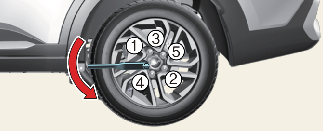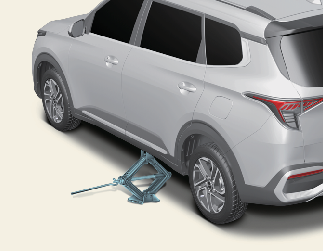Changing tyres
Operation
-
Stop the vehicle to a safe leveled place away from traffic.

-
Turn the hazard warning flasher on.
-
Set the parking brake.
-
Change the gear into R (Reverse) with Manual Transmission or P (Park) with Automatic Transmission.
-
Remove the jack, wheel lug nut wrench and the spare tyre from the vehicle.
-
Block both the front and rear of wheel that is diagonally opposite the jack position.

-
Loosen the wheel lug nuts counterclockwise one turn each. Do not remove any wheel lug nuts until the tyre has been raised off the ground.

-
Place the jack at the front (1) or rear (2) designated jacking positions.

-
Insert the jack handle into the jack and turn it clockwise. Raise the vehicle until the tyre just clears the ground. Make sure the vehicle is stable before removing the wheel lug nuts.

-
Loosen the wheel nuts and remove them by hand.
-
Slide the wheel off the studs and lay it flat so it does not roll away.
-
Pick up the spare tyre, line up the holes with the studs and slide the wheel onto them. Tip the wheel slightly and get the top hole in the wheel lined up with the top stud. Jiggle the wheel back and forth until the wheel slides over the other studs.
-
Hold it on the studs, put the wheel nuts on the studs and tighten them by hand. Jiggle the tyre to make sure it is completely seated.
-
Lower the vehicle to the ground by turning the wheel lug nut wrench counterclockwise.
-
Position the wheel lug nut wrench and tighten the wheel nuts. Be sure the socket is seated completely over the nut. Go around the wheel tightening every other nut until they are all tight. Double-check each nut for tightness.

After changing tyres, have your vehicle checked by a professional workshop or seek other qualified assistance. Kia recommends to call an authorised Kia dealer/service partner.

-
To prevent vehicle movement whilst changing a tyre, always set the parking brake fully, and always block the wheel diagonally opposite the wheel being changed.
-
We recommend that the wheels of the vehicle be chocked, and that no person remain in a vehicle that is being jacked.
-
To reduce the possibility of injury, be sure to use only the jack provided with the vehicle and in the correct jack position; never use any other part of the vehicle for jack support.
-
Wheels may have sharp edges. Handle them carefully to avoid possible severe injury. Before putting the wheel into place, be sure that there is nothing on the hub or wheel (such as mud, tar, gravel, etc.) that interferes with the wheel from fitting solidly against the hub. If there is, remove it. If there is not good contact on the mounting surface between the wheel and hub, the wheel nuts could come loose and cause the loss of a wheel. Loss of a wheel may result in loss of control of the vehicle. This may cause serious injury or death.
Wheel lug nut tightening torque
-
11~13 kgf·m (79~94 lbf·ft)

If the pressure is lower than recommended, drive slowly to the nearest service station and inflate to the correct pressure. If it is too high, adjust it until it is correct.

Your vehicle has metric threads on the wheel studs and nuts. Make certain during wheel removal that the same nuts that were removed are reinstalled - or, if replaced, that nuts with metric threads and the same chamfer configuration are used. Installation of a non-metric thread nut on a metric stud or vice-versa will not secure the wheel to the hub properly and will damage the stud so that it must be replaced.
Note that most lug nuts do not have metric threads. Be sure to use extreme care in checking for thread style before installing aftermarket lug nuts or wheels. If in doubt, consult a professional workshop. Kia recommends to consult an authorised Kia dealer/service partner.

-
If the studs are damaged, they may lose their ability to retain the wheel. This could lead to the loss of the wheel and a collision resulting in serious injuries.
-
Check the inflation pressures as soon as possible after installing the spare tyre. Adjust it to the specified pressure, if necessary. Refer to More Details.